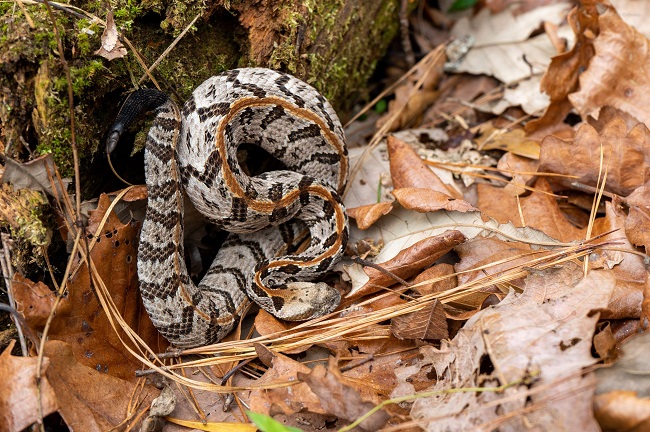
The timber rattlesnake (Crotalus horridus) is a species of venomous snake known for its remarkable adaptability and distinctive warning mechanism—the rattling sound produced by its tail. These serpents are native to North America and play an important ecological role in their forested habitats.
Habitat and Range
Timber rattlesnakes are primarily found in the eastern United States, ranging from Minnesota to Texas and as far east as New Hampshire and Florida. They display a strong affinity for deciduous forests and are often associated with rocky outcrops, ledges, and boulder fields within these habitats. The snakes are particularly fond of areas with dense understory vegetation, which provides cover for hunting and thermoregulation.
Timber rattlesnakes are skilled climbers and seek shelter in rocky outcrops that provide essential hibernation sites. These dens are commonly found in areas such as crevices, caves, and abandoned mammal burrows. The thermal properties of these rocky habitats help maintain suitable hibernation temperatures during winter, allowing the snakes to survive the colder months when their metabolic rate decreases significantly.
During the warmer months, timber rattlesnakes leave their hibernation dens and engage in seasonal movements. They often travel several miles to forage, find mates, or seek out more favorable basking locations. These movements are influenced by factors such as prey availability, temperature, and reproductive needs. However, timber rattlesnakes generally exhibit fidelity to their preferred home range and return to familiar den sites each winter.
Timber rattlesnakes prefer diverse forested habitats that provide an array of microhabitats, including both open and shaded areas. Within their range, they can be found in deciduous forests, mixed hardwood forests, pine-oak forests, and even coniferous forests. Such habitat diversity ensures a variety of prey species and suitable basking spots for the snakes.
Importance within the Ecosystem
Timber rattlesnakes play a crucial role in their ecosystem. As apex predators, they help control rodent populations, thus influencing the balance of prey species in their habitats. By regulating rodent numbers, these snakes indirectly impact plant communities and reduce potential damage caused by excessive herbivory.
Conservation and Challenges
The conservation of timber rattlesnakes is of great importance due to habitat loss, fragmentation, and persecution. Timber rattlesnake populations are particularly vulnerable to habitat destruction caused by human activities such as deforestation, urbanization, and road construction.
Additionally, human fear and misunderstandings often lead to snake killings, further threatening their populations. Conservation efforts focus on habitat protection, public education, and the promotion of coexistence with these vital reptiles.
Timber rattlesnakes are remarkable creatures, uniquely adapted to their forested habitats. Their affinity for rocky outcrops, reliance on diverse forest ecosystems, and seasonal movements are all integral aspects of their life history. Understanding the habitat preferences and ecological importance of timber rattlesnakes allows us to appreciate their role in maintaining the delicate balance of North American forests. Conservation efforts are vital to safeguard these magnificent snakes and ensure their continued presence in our natural landscapes.
8 Fun Facts About Timber Rattlesnakes
Unique Rattle
Timber rattlesnakes are known for their distinctive rattle, which is composed of loosely interlocking segments called “keratin buttons.” When threatened, the snake vibrates its tail rapidly, creating a rattling sound. Each time the snake sheds its skin, a new button is added to the rattle, making it longer.
Venomous Bite
Timber rattlesnakes possess venom that they use to immobilize their prey. Their venom is primarily used for hunting, and they are generally not aggressive toward humans unless provoked. However, if bitten, it is crucial to seek immediate medical attention as their venom can cause severe tissue damage and other health complications.
Thermal Sensors
Like other pit vipers, timber rattlesnakes have specialized heat-sensing organs called “pit organs” located between their nostrils and eyes. These infrared sensors allow them to detect heat emitted by potential prey, enabling accurate strikes even in low-light conditions.
Sluggish Metabolism
Timber rattlesnakes have a slow metabolic rate, allowing them to survive on fewer meals compared to more active snake species. They can go several months without eating, especially during hibernation periods when their metabolism significantly decreases.
Viviparous Reproduction
Timber rattlesnakes are viviparous, meaning they give birth to live young instead of laying eggs. The females carry the developing embryos inside their bodies, and the young snakes are born fully formed and capable of independent survival.
Elaborate Camouflage
Timber rattlesnakes have remarkable camouflage that helps them blend into their natural surroundings. Their coloration and pattern resemble the leaf litter and rocks found in their habitats, providing effective camouflage, and aiding in their ambush hunting strategy.
Long Lifespan
Timber rattlesnakes are known for their longevity. In the wild, they can live up to 20 years or more, while some individuals in captivity have been recorded to live well over 30 years.
Slow Movements
Timber rattlesnakes are generally slow-moving snakes. Their methodical and deliberate movements allow them to conserve energy and remain hidden from potential threats and prey.
Related Articles & Free Email Newsletter Sign Up
Cassowaries are Considered to be the World’s Most Dangerous Bird
How to Choose Your First Reptile or Amphibian


Comment here